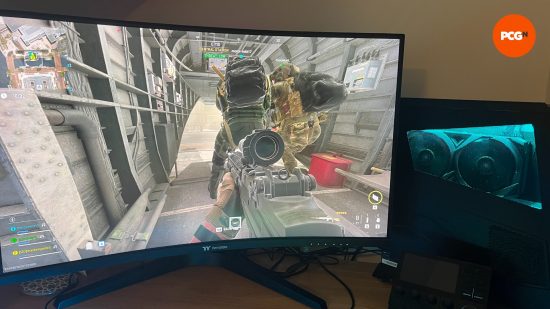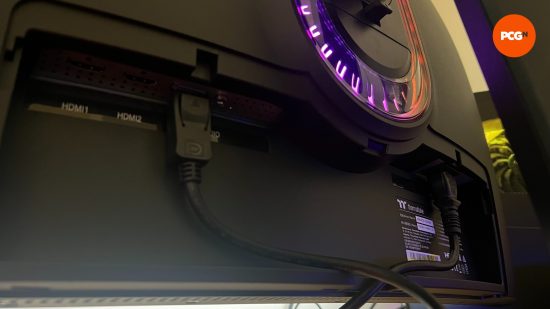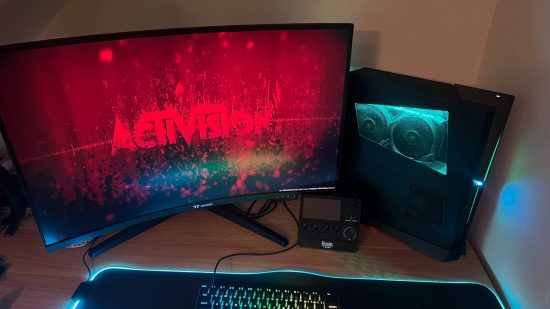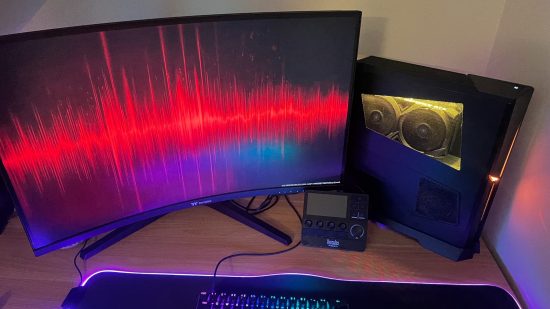Our Verdict
The Thermaltake TGM-V32CQ is perfectly fine, I wish I could laud over its incredible performance and features, but they simply aren't present. Objectively this gaming monitor is very capable but just finds itself overshadowed in the current market.
It’s rare to come away from testing a product feeling frustrated, but that’s exactly how I feel following my time with the Thermaltake TGM-V32CQ curved gaming monitor. This is not a bad gaming monitor, far from it, but perhaps I expected more and just when I felt like there were moments when it would live up to the potential, it would soon slip away once again.
While it would be hard to find a case for calling the Thermaltake TGM-V32CQ one of the best gaming monitors around, it is a fine example of a curved display available for a reasonable price. Thermaltake can take pride in that it produced a monitor that, on paper, was far behind other models I was testing at the same time, but still pushed them in terms of performance, eventually falling short on that final layer of quality.
Why you can trust our advice ✔ At PCGamesN, our experts spend hours testing hardware and reviewing games and VPNs. We share honest, unbiased opinions to help you buy the best. Find out how we test.
Pros
- AMD FreeSync/Nvidia G-Sync compatible
- Thin bezel maximizes screen real estate
Cons
- Curvature causing distortion when not head-on with the display
- Color gamut could be better
- I/O placement
- Occasional blurring despite response time
| Screen Size | 31.5 inches |
| Native Resolution | 2650×1440 |
| Max Refresh Rate | 165Hz |
| Panel Type | VA |

Thermaltake TGM-V32CQ features
The Thermaltake TGM-V32CQ is a QHD (2650×1440) curved monitor with a VA panel and 165Hz refresh rate. This output is only possible via the DisplayPort, with the HDMI 2.0 ports capable of 144Hz maximum.
It has a 90% DCI-P3 color gamut, which is behind many mid-to-top-tier monitors. There is an anti-glare panel to ensure that direct light disruption is limited.
The Thermaltake TGM-V32CQ is versatile with its swivel and pivot capabilities, but you won’t have as much freedom to change its orientation entirely.
There are LED lights on the rear, surrounding the point of contact where the stand connects to the display. It also has a hidden I/O courtesy of a cable cover that easily slides on and off.

Thermaltake TGM-V32CQ design
The Thermaltake TGM-V32CQ had me with its simple design, but the longer I spent with it, the more it came to bug me. An issue I just couldn’t get over was the I/O placement and the cover it comes with. Cables need to be awkwardly angled to fit in such a tight space and trailing them through the indent to replace the cover is a nightmare, especially if you have more than two cables in at any one time.
These ridge I/Os are a pain at the best of times, so this design choice from Thermaltake left me exasperated. Even once a cable was in, messing around with the wiring to feed it through properly would usually jiggle the connection and disconnect it. This was a constant battle that could have easily been avoided.
In better news, the RGB placement on the back of the monitor is a nice addition but practically something that you’ll never really pay attention to unless you’re gaming in quite a dark space.
Props have to be given for the thin bezel, which helps the Thermaltake TGM-V32CQ feel grander in scale than the standard 31.5-inch display. The 1000R curve screen is a nice touch, but suffers from the same viewing angle issues as many others, in that as soon as you move around, the image quality plummets.

Thermaltake TGM-V32CQ performance
The Thermaltake TGM-V32CQ passed all of my initial color quality, text clarity, gamma, and brightness testing with no major faults found. More important was how it performed when gaming and I always like to take a selection of games to test. In the case of the Thermaltake TGM-V32CQ, I used Doom Eternal, Warzone 2, and Resident Evil 2.
In all of these games, the PCGN testing rig I use is capable of hitting more than 165 fps, meaning I could push the Thermaltake TGM-V32CQ to its 165Hz limit. I was quite happy with the overall performance but it always felt like a little something was missing. I think this mostly comes from having tested a few very similar monitors alongside it, and they all outshone it in the color range, accuracy, and brightness, and some of them were targeted as a budget option.
There would be noticeable moments in gameplay where the image would become a little distorted as colors settled. The brightness was typically never an issue, with 400 nits and a 3000:1 contract ratio to back this up.
It should be noted that the Thermaltake TGM-V32CQ is often advertised as a 1ms GtG (grey to grey) display, but its typical GtG response time is 4ms, which can be quite noticeable with certain scene changes and in ultra-fast gameplay like Doom. The MPRT (motion picture response time) is performing at the typical 1ms.
While I can appreciate the MPRT inclusion, it’s a more subjective figure, given how an individual may react to certain motions that happen on screen. GtG is objective and determines how long it takes for a pixel to change from one grey value to another. In short, the GtG typical response time being quite far behind here is a far bigger deal than having a 1ms MPRT response time.
I also hooked up an Xbox Series S to ensure there was no issue with console performance and I’m happy to report it worked perfectly, as you would expect given both AMD FreeSync Premium and G-Sync compatibility is included.
Should you buy the Thermaltake TGM-V32CQ?
As an outright choice, I wouldn’t recommend the Thermaltake TGM-V32CQ at its current RRP of $309.99 / £349.90. There are far too many monitors of better quality that sit at a similar price point.
Ultimately, I would recommend the MSI MAG 32CQRF QD ahead of this, as it can be found for a very similar price – often cheaper in the right places – and it has a stronger performance, particularly on the color range and accuracy.
Verdict
Ultimately the Thermaltake TGM-V32CQ is a fine curved gaming monitor that comes from a reliable brand with a pedigree in other component markets.
Its performance is just a step behind the other mid-tier monitors we’ve tested recently, and a bizarre design choice on the I/O left me frustrated with a monitor that I wanted to love, but now just appreciate for what it is.
